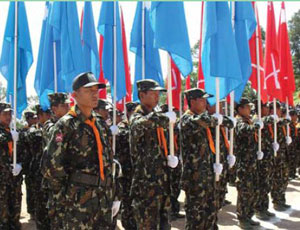Shan troop units have withdrawn into the jungle after burning their camps in central Shan State, a source said. Shan State Army North (SSA-N) headquarters on Sunday instructed its units stationed at Wan Et ...
Chiang Mai (Mizzima) – Shan troop units have withdrawn into the jungle after burning their camps in central Shan State, a source said.
 Shan State Army North (SSA-N) headquarters on Sunday instructed its units stationed at Wan Et, Mong Nang sub-township, in Wan Kang Township, and Wan Tu Ya in Mong Nawng Township to pull out. The instruction came after a unit of the Burmese Army attacked the group last Friday, the source close to the SSA-N said.
Shan State Army North (SSA-N) headquarters on Sunday instructed its units stationed at Wan Et, Mong Nang sub-township, in Wan Kang Township, and Wan Tu Ya in Mong Nawng Township to pull out. The instruction came after a unit of the Burmese Army attacked the group last Friday, the source close to the SSA-N said.
Meanwhile, the Shan Herald Agency for News (SHAN) reported today, quoting sources close to the army, that Burmese Army units based around areas controlled by the SSA-N had recently been ordered to closely monitor the group’s movements.
“We were told to follow, arrest and interrogate anyone coming from the Brigade 1 area if they came out for shopping, health treatment or any other reason,” a source quoted a Burmese Army officer as saying.
The firefight last week started when a unit of Light Infantry Division (LID) 33 ran into a patrol from SSA-N Battalion 24 early on Friday evening. The battle lasted 45 minutes. The incident occurred at Kunkieng-Wanlwe, three miles (around five kilometres) west of Wanhsaw, a village near Wanhai, the SSA-N’s main base.
According to the source, “The SSA-N troops have burned their camps and disappeared into the jungle. The situation is very tense and people are afraid that the Burmese troops might launch reprisals against them.”
However, the SSA-N’s main base remains in Wan Hai, Kesi Township, in northern Shan State. Troops were also alerted to the tense situation and were instructed to shoot on sight any Burmese troops that crossed the demarcation lines of their controlled area without informing SSA-N headquarters.
One analyst said: “The intention of the pull-out is to prepare for potential clashes and to avoid becoming a target for the Burmese troops.”
When asked if this was the end of the ceasefire agreement, he said: “The ceasefire agreement came to an end on September 1. It is a testing time for the ceasefire groups, whether they are ready for a clash or not. The Burmese Army will not confront all the ceasefire groups at the same time because they would face multiple counter-attacks
from the different armed ethnic groups.”
He added: “The previous fighting between the SSA-N and Burmese troops was just [the junta] testing the water. It is just a matter of time until the Burmese Army eliminates another armed opposition group.”
However, junta troops might not have such an easy time if that is their goal. Six major armed ethnic opposition groups reached a landmark deal to join forces against the Burmese Army at a meeting on November 3, 2010 at Mae Hong Son in neighbouring Thailand.
Alliance members in addition to the SSA-N are the Karen National Union, Karenni National Progressive Party, Chin National Front, Kachin Independence Organisation, New Mon State Party and the Shan State Army-North.
Recent tensions between armed ethnic ceasefire groups and Burmese forces flared up after the Burmese Army pressured them to bring their troops under junta command within the Border Guard Forces. The proposal was strongly rejected by the United Wa State Army, National Democratic Alliance Army, aka Mong La group, and SSA-N Brigade 1 in Shan State, based along the Sino-Burmese border.



